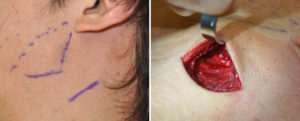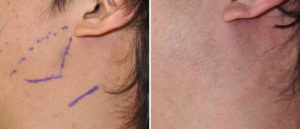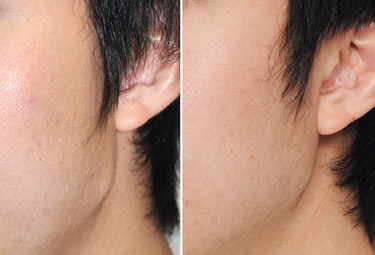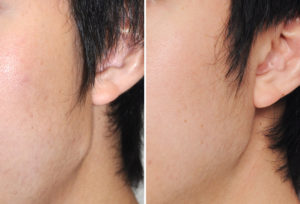Background: While chin implants have been around a long time for increasing projection of the front of the jaw, jaw angle implants have been far less used for augmentation of the back of the jaw. As a result a good understanding of the anatomy and the surgical technique to place them is not as well known.
Chin implants require partial release of the subcutaneous insertion of the mentalis muscle for placement. Conversely jaw angle implants require efforts to preserve the insertion of the masseter muscle around the inferior border. (pterygomassteric sling) While these muscle differences in pocket dissection may seem trivial, they have very different aesthetic implications.
The key anatomic issue in the subperiosteal pocket creation for any implant in the jaw angle region is preservation of the pterygomasseteric sling. For jaw angle implant that only have a widening effect this is easier since the dissection only needs to go right to but not around the inferior border of the ramus. But for any implant that vertically extends the jaw angle length by any amount it becomes necessary to carry the dissection around the inferior border. This requires gentle elevation of the very thin periosteal connection of the masseter and pterygoid muscles that meet at the inferior border.
Should such inferior border attachments become separated the resultant postoperative sequelae is the potential for masseter muscle dehiscence. This occurs because the muscle’s insertion is on the bony angle point and lateral ramus border. This will be seen as the angle of the implant being clearly seen with a muscle bulge above it. There is no functional issues with masseter muscle angle dehiscence as the muscle has maintained attachments to the coronoid process and other parts of the ramus for continuation of its mouth opening and mastication capabilities. This is a purely aesthetic issue
Management of masseter muscle dehiscence over an implant can be done several ways. The easiest approaches to camouflage it with soft tissues fillers or a subcutaneous implant. Treating the actual problem requires efforts at trying to reposition the muscle back over the implant angle point.



The direct approach to masseter muscle dehiscence repair requires a neck skin incision. I know of no way to do so from an intraoral approach. Incisional placement can be done at two locations, directly over the angle and through a much lower neck incision. Each has their advantages and disadvantages. If one has a heavy beard with good density over the jaw angle area the direct incisional approach provides easier access and repair and zero risk of injury to the marginal mandibular branch of the facial nerve. If beard hair is very slight or non-existent then a lower neck incision is preferred…which can be more challenging and has a risk, albeit low, of nerve injury.
Case Highlights:
1) One aesthetic risk of jaw angle implants is masseter muscle dehiscence.
2) One treatment option for correction of masseter muscle dehiscence is muscle repositioning through an external neck incision.
3) Improvement of muscle coverage over the angle of the implant is possible with an acceptable neck scar tradeoff.
Dr. Barry Eppley
Indianapolis, Indian




